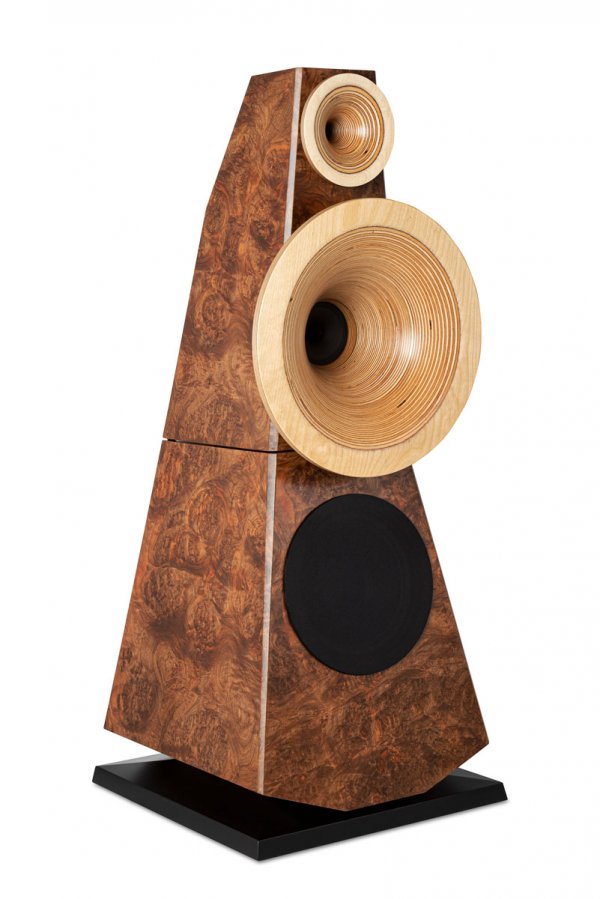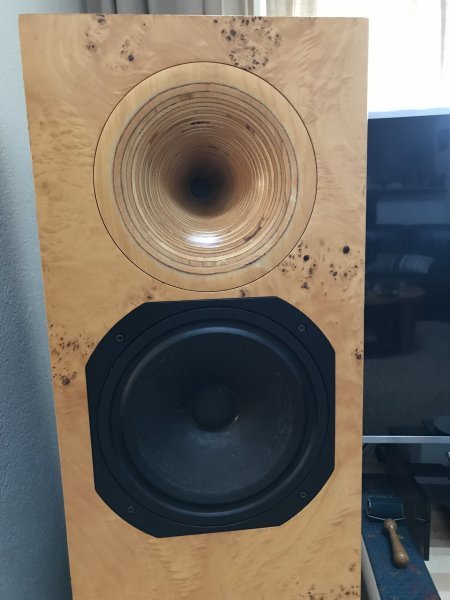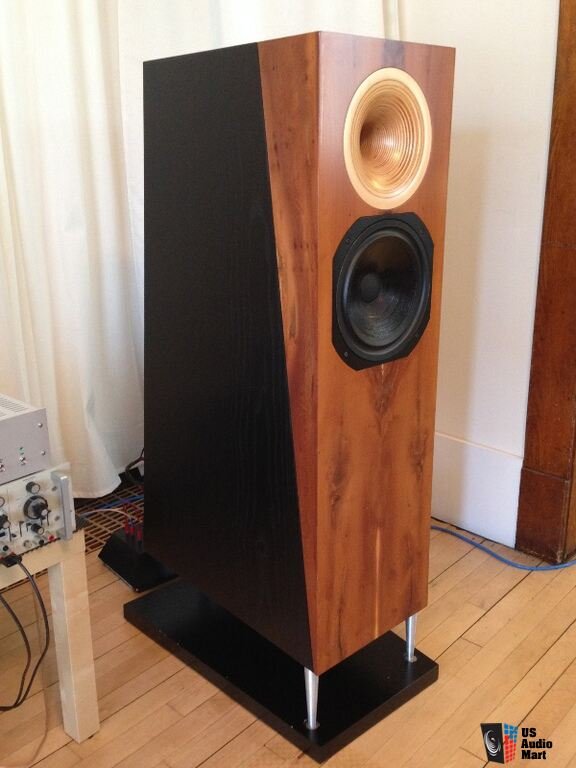https://highendaudio.nl/product/avantgarde-duo-series-3-0/?lang=en. Which is why commercial products like AG and Cessaro horns can be great buys, especially some of the older AG models...
A bargain!
https://highendaudio.nl/product/avantgarde-duo-series-3-0/?lang=en. Which is why commercial products like AG and Cessaro horns can be great buys, especially some of the older AG models...
No, it is Charney Audio.
Two different guys I believe. I never really adopted A'Gon's forum. I'm sure there were/are some interesting bits there.yes I am aware of Dave Slagle's Lowther FC though never got to hear it. A guy who had made horns out of that moved to Slagle's stacked quads I think, if you are referring to John P on the gon.
To a point I agree, though I've heard a few compelling systems wherein a full ranger was employed as an extended midrange to fine effect. In my room at that time, listening to my typical fair, (a fairly eclectic mix with highlights in small group jazz, chamber music, big bands, orchestral, what I would call New Orleans rooted music and some contemporary classical) the bass bins gave more than they took, running the horns full range. I suppose it comes to taste and environment.yes but the whole point of running full range AER is not having a crossover, imo, to bass bins. The AER in Oris were up to BD3, even lower, and there were significant jumps to BD4 and from BD4 to BD5. Bill and I heard from BD4 to BD5 and Murat has a video where he shows difference between BD3 and BD3b.
It sounds as though this train of discussion is headed towards a listening expedition : )Yes I love dual woofer front loaded horns which do exactly that, have a good CD on top and two woofers at bottom. You can throw any music at them and they can accommodate a range of SETs and low watt push pulls. You don't lose anything on a Pnoe BD5 listening to large orchestral works like Beethoven 9th or Mahler 2. In fact you gain more because not having the crossover increases the dynamic range. But this can be heard only on high quality LPs.
Great experience on your part, though, having gone through these horns.
Interesting. It just seemed, on an intuitive level, that a wood horn would remove the plastic coloration that I (imagined?) I was hearing. The coloration I heard from the horns was never due to amplification. It always seemed to be a result of horn material itself.The horn colouration you heard is down to partnering amplification, cabling and system set up which the AG's are extremely critical of. If its not done right you will hear it!
Wood horns will produce more colouration than ABS or Kevlar if done correctly. Remember spherical horns are as near to perfect horns you can get. Cessaro when from machined wood horns to their current kevlar/glassfibre horns and the difference between the two from an audio prospective was night and day. If you were making a horn today there is no reason to use wood, other than because it is cheap. There are vastly better materials available today to make good horns from.
Ahh, I had forgotten about Brian's work. Shame on me. I didn't know he was offering field coils but it makes sense that he would.
It sounds as though this train of discussion is headed towards a listening expedition : )
We're welcoming a new location in France later this year, so perhaps neutral ground : )Sorry - to clarify, Charney is making AER based speakers, BLH, smaller than Pnoes. Not field coils
Oh you have been on my watchlist- my US trips will take time.
Interesting. It just seemed, on an intuitive level, that a wood horn would remove the plastic coloration that I (imagined?) I was hearing. The coloration I heard from the horns was never due to amplification. It always seemed to be a result of horn material itself.
The best amplification I found by far, after years of trying different SET tube amps, was the solid state Bakoon 23r. It had the AG's absolutely singing with unforced, natural sound. The Enleum low watt amp is the new version of the Bakoon.
Indeed, very well said Bill! Just because Cessaro changed from wood to synthetic materials doesn't mean anything definitive over and above the implication that the designer preferred the colorations from his new horns over his old wood ones. At least in going from the small Chopin to it successor Wagner, it seems that they also may have changed the profile of the horn and also possibly the compression driver, both of which could have a profound effect on the sound.What you have written is perfectly correct. It is also a monumentally more complex thing than one first thinks. The type of material is only one component to it, the thickness of walls, finish, type of wood, adapter - literally everything make a difference.
Also to be clear - making a horn in “wood is cheap” is an idiotically ignorant statement. If one were to attempt to make a full Cessaro type horn in solid ebony (which would be extremely challenging but technically viable) or rosewood, the costs of materials alone would be horrifyingly high let alone getting someone to risk the manufacture.
There is very good reason that Aries Cerat employ wood in their horn systems including Symphonia, Contendo, and their new model. There is also very good reason that Sierra audio do the same as well as many others - it isn’t because they can do it cheap lol.
Unfortunately everything has a resonance profile that imparts some form of its own impact on the end product. It is no surprise that some people adore the sonics of paper cones / woofers modern and vintage and can’t stand glass fibre and other materials for their drivers. This is no accident.
Your experience is reflected in my experience and many others. I have ABS and wood horns in same profile and one can easily hear the substrates. One can hear the substrate in Cessaro horns as well as the Pnoe easily. Your brain adjusts pretty rapidly though and it doesn’t make them bad but the colour is there. To claim otherwise is nonsense.
Also Amplification has little impact on this horn substrate colour. I have heard Pnoe with all manner of amps and the same profile is there regardless.
Sorry - thought I would share not only my direct experience but opinion on this topic.
PS. Ask Stavros about costs and difficulty together with rationale in manufacturing his Contendo mid bass horn lol. It is one thing me saying it, but best coming from a large manufacturer like that. Or watch a video from the Aries Cerat YouTube page.
I can also say that one of the reasons I think I like AC horns and Odeon horns has to do with the wood horns.What you have written is perfectly correct. It is also a monumentally more complex thing than one first thinks. The type of material is only one component to it, the thickness of walls, finish, type of wood, adapter - literally everything make a difference.
Also to be clear - making a horn in “wood is cheap” is an idiotically ignorant statement. If one were to attempt to make a full Cessaro type horn in solid ebony (which would be extremely challenging but technically viable) or rosewood, the costs of materials alone would be horrifyingly high let alone getting someone to risk the manufacture.
There is very good reason that Aries Cerat employ wood in their horn systems including Symphonia, Contendo, and their new model. There is also very good reason that Sierra audio do the same as well as many others - it isn’t because they can do it cheap lol.
Unfortunately everything has a resonance profile that imparts some form of its own impact on the end product. It is no surprise that some people adore the sonics of paper cones / woofers modern and vintage and can’t stand glass fibre and other materials for their drivers. This is no accident.
Your experience is reflected in my experience and many others. I have ABS and wood horns in same profile and one can easily hear the substrates. One can hear the substrate in Cessaro horns as well as the Pnoe easily. Your brain adjusts pretty rapidly though and it doesn’t make them bad but the colour is there. To claim otherwise is nonsense.
Also Amplification has little impact on this horn substrate colour. I have heard Pnoe with all manner of amps and the same profile is there regardless.
Sorry - thought I would share not only my direct experience but opinion on this topic.
PS. Ask Stavros about costs and difficulty together with rationale in manufacturing his Contendo mid bass horn lol. It is one thing me saying it, but best coming from a large manufacturer like that. Or watch a video from the Aries Cerat YouTube page.
I can also say that one of the reasons I think I like AC horns and Odeon horns has to do with the wood horns.
No its not...it is lacquered wood.Only the new 80+ k Odeon are wood. Where are the 28, 32, 38 wood? The horn part was composite.
Or natural wood...do a bit of google and you will see.No its not...it is lacquered wood.
Only the new 80+ k Odeon are wood. Where are the 28, 32, 38 wood? The horn part was composite.



I, along with many others were witness to the differences in horn sound when we exhibited with both wood horns (Munich 2012) and carbon fibre/rubber resin horns (Munich 2013 & 2014). The lack of colouration was significant going from wood to modern non resonant materials which is why Cessaro made the huge investment in making the change for future production of horns.Indeed, very well said Bill! Just because Cessaro changed from wood to synthetic materials doesn't mean anything definitive over and above the implication that the designer preferred the colorations from his new horns over his old wood ones. At least in going from the small Chopin to it successor Wagner, it seems that they also may have changed the profile of the horn and also possibly the compression driver, both of which could have a profound effect on the sound.
I, along with many others were witness to the differences in horn sound when we exhibited with both wood horns (Munich 2012) and carbon fibre/rubber resin horns (Munich 2013 & 2014). The lack of colouration was significant going from wood to modern non resonant materials which is why Cessaro made the huge investment in making the change for future production of horns.
I, along with many others were witness to the differences in horn sound when we exhibited with both wood horns (Munich 2012) and carbon fibre/rubber resin horns (Munich 2013 & 2014). The lack of colouration was significant going from wood to modern non resonant materials which is why Cessaro made the huge investment in making the change for future production of horns.
Also to be clear - making a horn in “wood is cheap” is an idiotically ignorant statement. If one were to attempt to make a full Cessaro type horn in solid ebony (which would be extremely challenging but technically viable) or rosewood, the costs of materials alone would be horrifyingly high let alone getting someone to risk the manufacture.
Yep, that's why musical instruments are made of such materials. Oh wait...
Agree Mani. And then you’ll hear back that this isn’t relevant argument but it fully is because everything has a resonance profile and sounds. Imagine your Anima’s mid range replaced with a big ABS Oris. I have a hunch that you’ll not like it as much.
My reference to wood horns being cheap, is anyone can get a few sheets of plywood, which is what the majority of commercial horns are made from, cut them into squares sections and glue them together and then machine them on a wood lathe. This is cheap when you consider the huge cost of getting moulds made for serious production. I remember talking to Holger Fromme (owner of AG) back in the mid 1990s and he told me the moulds for the original Trios were massively expensive. Think in excess of €100,000 for each horn. From this you can also tell who are the serious manufacturers. Anyone making horns out of ebony or rosewood would either be in very small scale manufacturing, or the DIY arena because a lot of that type of wood is banned from use in a lot of countries today.
You won't find many musical horn instruments made from wood apart from the Oboe, Clarinet and bassoon and these are not strictly horn instruments. Whereas the Trumpet, Tuba, French horn, Saxophone, Trombone are all made from brass not wood.Yep, that's why musical instruments are made of such materials. Oh wait...
| Steve Williams Site Founder | Site Owner | Administrator | Ron Resnick Site Owner | Administrator | Julian (The Fixer) Website Build | Marketing Managersing |














